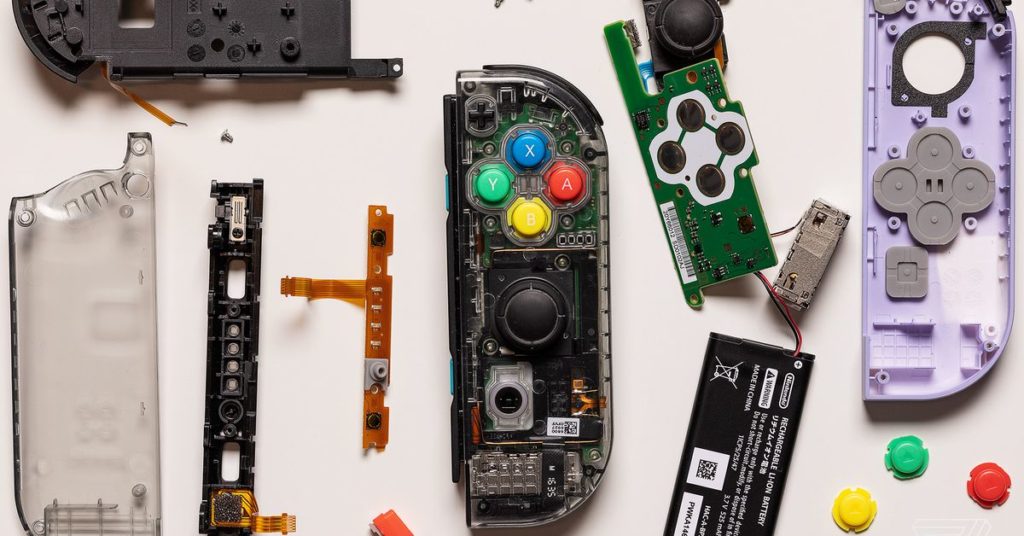How to customize the look of your Nintendo Switch Joy-Con controllers
If you’ve ever wished that your Nintendo Switch Joy-Con controllers had a little more color, you have two options: buy a new $80 set, selecting from the very limited batch of color options that Nintendo makes, or customize the ones that you already own.
I’m not talking about simply applying some decal stickers.
Several manufacturers sell replacement cases for Joy-Con controllers, and a search on Amazon will show you just how much variety there is. There are matte-textured ones, like those Nintendo makes, or ones with a glossy finish. There are pastel-colored cases, as well as translucent options if you’re feeling nostalgic for the see-through Nintendo 64 and Game Boy Color. And you can even find cases that include a proper directional pad replacement for the left-hand Joy-Con (making it similar to the one used in the Nintendo Switch Lite).
The big upside of this project is that your Joy-Cons will stand out from the crowd of default color options, and you can get a few sets of vibrant Joy-Con shells for far less than the cost of a set of new Switch controllers.
:no_upscale()/cdn.vox-cdn.com/uploads/chorus_asset/file/19289196/akrales_191003_3691_0261.jpg)
But there are a few downsides as well. You’ll (probably) void your controllers’ warranty when you open them up to transplant the parts. While you don’t need to tear any warranty stickers to get inside of a Joy-Con, should you ever need to have one fixed, Nintendo will probably be able to figure out that you’ve been mucking about inside.
Also, this project isn’t as simple as you might think. Thankfully, you won’t have to do any soldering, but there are a ton of screws, ribbon cables, and other very small parts inside of each Joy-Con that you’ll have to carefully detach, then reattach.
Before we get started, two things. First, if you’re swapping cases for both Joy-Con controllers, start with the left controller. It’s far easier to operate on than the right one, and it will serve as an intro to fiddling with Joy-Con internals. The right controller houses more parts, and they’re more intricately organized, making for a tougher time if you don’t already know the general layout.
Second, as you’ll soon find out, I’m not a professional at taking things apart. You may be able to do this in a faster, more elegant, and perhaps more organized manner. But I let my bliss and curiosity guide me, and it led me to some colorful Joy-Cons that work perfectly. It can work out for you, too, with the right tools and a lot of patience.
So let’s start.
:no_upscale()/cdn.vox-cdn.com/uploads/chorus_asset/file/19289195/akrales_191003_3691_0254.jpg)
For some, this might be a tough step. At Amazon, there are plenty of colors to choose from, and you can mix and match to your liking. Use your imagination and go wild with it. I purchased a set of translucent charcoal Joy-Con shells, complete with colored face buttons in the styling of the Super Famicom. I also bought a set of matte-textured periwinkle shells because that color is highly underrepresented in gaming accessories, and it’s also one of my favorite colors. Each set costs around $20.
You can get creative by using the Joy-Con shells that you already own. Say you have a pair of gray Joy-Con, and a pair of neon blue and red. You can swap those colors around for a unique look without having to spend money on new shells.
:no_upscale()/cdn.vox-cdn.com/uploads/chorus_asset/file/19289153/akrales_191003_3691_0022.jpg)
iFixit’s Pro Tech toolkit has way more tools than you’ll need for this project, including everything you’ll need to get inside of your Joy-Con. This kit costs $59.99, and if you like to do projects like this regularly, it’s well worth the cost.
If you want to go a la carte, here are the essentials that I used for this project:
- Opening picks (to pry open the Joy-Con)
- Spudger (to gently detach and reattach components)
- A screwdriver with two bits. First, a J00-type JIS bit to use on the innards of the Joy-Con — it looks similar to a Phillips head, but differs in subtle and important ways. Second, a Y00-type tri-point bit for the screws holding the Joy-Con together.
:no_upscale()/cdn.vox-cdn.com/uploads/chorus_asset/file/19289175/akrales_191003_3691_0118.jpg)
- Open up the Joy-Con using the Y00-type screw bit, and store the screws carefully.
:no_upscale()/cdn.vox-cdn.com/uploads/chorus_asset/file/19289173/akrales_191003_3691_0101.jpg)
- Use an opening pick or a thin card to open up the Joy-Con, gently separating the two sides along the rounded edge so you don’t pull on the ribbon cables holding them together.
:no_upscale()/cdn.vox-cdn.com/uploads/chorus_asset/file/19289172/akrales_191003_3691_0099.jpg)
- Gently pry the battery out with the spudger. (You can see I’m using a metal one, but plastic would be even safer: you don’t want to accidentally puncture the cell.) The battery is secured to the black middle plastic section with some adhesive, but it doesn’t take much effort to lift it up. Just do it carefully so you don’t bend the battery. As you proceed, try to keep the adhesive dust-free so that it retains some stickiness when you reinsert the battery later on.
- (Note on dealing with adhesive: The battery and a few other vital components that you’ll encounter in this operation are secured by adhesive. It’s not particularly strong adhesive, just a small, sticky strip applied to certain parts. So, you don’t need to worry about making a mess, and as long as you’re careful when removing the adhered components, you shouldn’t have an issue getting the adhesive to stick when it’s placed in the new case.)
:no_upscale()/cdn.vox-cdn.com/uploads/chorus_asset/file/19289170/akrales_191003_3691_0095.jpg)
- With the battery lifted out, unscrew the black plastic cover that’s held down by two J00-type screws. Store them carefully, then lift out the plastic to reveal the main board.
:no_upscale()/cdn.vox-cdn.com/uploads/chorus_asset/file/19289167/akrales_191003_3691_0065.jpg)
- You can make the next few steps a little easier by detaching the rear part of the case. Use the metal spudger to lift the small switches that secure the two ribbon cables leading to the Joy-Con’s rail (I’m holding it in my fingers in the picture above). Once the switches are up, you can gently pull the cables out.
:no_upscale()/cdn.vox-cdn.com/uploads/chorus_asset/file/19289166/akrales_191003_3691_0060.jpg)
- If you want to switch your Joy-Con’s SL and SR buttons, unscrew the board covering the Joy-Con rail, exposing them and its sync button. If your replacement shells came with new buttons, you can pop them in now, taking care not to accidentally put the SL button in the SR slot. Also ensure that the rubber membrane covering the sync button is properly seated before you screw the small board back onto the rail.
- While you’re on this step, lift up the switch holding the ribbon cable that leads to the ZL button (fastened into the black plastic piece at the top of the image above), then gently pull it out. Not having this in your way will make the rest of the process a little easier.
:no_upscale()/cdn.vox-cdn.com/uploads/chorus_asset/file/19289164/akrales_191003_3691_0050.jpg)
- Remove the last two J00-type screws holding the green board into the Joy-Con housing (if you haven’t already done so) and keep track of those screws. Detach the L button, the minus button, and their respective circuitry, which are held down by J00-type screws from the Joy-Con. Take special care when you lift the L button out of the housing, as its spring can easily go flying out.
- You can leave these ribbon cables attached to the main board, which will make life easier when you put the components into a new Joy-Con case.
:no_upscale()/cdn.vox-cdn.com/uploads/chorus_asset/file/19289162/akrales_191003_3691_0045.jpg)
:no_upscale()/cdn.vox-cdn.com/uploads/chorus_asset/file/19289159/akrales_191003_3691_0037.jpg)
- We’re getting close to the end for the left Joy-Con, but some of the trickiest steps are still ahead of us. Unscrew the analog stick’s two J00-type screws, then carefully pull the stick out, being mindful of the small plastic gasket (visible in the picture below) that’s in place between the stick’s housing and the Joy-Con shell. You’ll need to transplant this gasket into your new case, so be very careful.
- This might help: there’s a deliberate break in the gasket which you can lift up to easily make room for the stick to pull through. But if you’re moving every component into a new Joy-Con case, you should fully remove the gasket along with the stick. To do this without ripping it, gently lift up on the gasket where it’s attached to the case by adhesive, then keep it in a safe place until you’re ready to put it in the new case. Just don’t forget to reapply the gasket because its job is to keep dust and other grime out of your Joy-Con.
:no_upscale()/cdn.vox-cdn.com/uploads/chorus_asset/file/19289158/akrales_191003_3691_0035.jpg)
- You can finally remove all of the major components out of the Joy-Con shell, including the HD rumble motor that’s seated with some adhesive. Congrats on getting this far!
- You can see the membranes that cover each of the buttons, including the minus button, the four face buttons, and the screenshot button. Go ahead and lift those away to reveal the plastic buttons underneath, but be sure to reapply them exactly as they were when you removed them. You can also remove the L button, but again, keep a close eye on its spring. Our replacement cases didn’t come with springs, so you’ll be in a tough spot if you lose it.
:no_upscale()/cdn.vox-cdn.com/uploads/chorus_asset/file/19289154/akrales_191003_3691_0023.jpg)
- Now you can swap out the buttons and pop them into your new case. Thankfully, the button fixtures are notched in such a way that they only go in one way, though make sure that you have the correct button in each slot. It’s easy to get disoriented, unintentionally placing the A button in the B button slot, so give your work a second check, or you may have to completely disassemble your Joy-Con to repeat this step.
- One last note: if you intend to switch out the middle black plastic piece that has the ZR button fastened to it, you’ll need to remove the button and its circuitry, which is held by a screw. It’s not an easy feat to get the button off, since it’s snapped into the plastic fixture. I had luck gently prying it off with the metal spudger, but keep in mind that there are springs directly underneath the button, so hold your hand over it as you remove it, and keep a close eye on them.
:no_upscale()/cdn.vox-cdn.com/uploads/chorus_asset/file/19289176/akrales_191003_3691_0124.jpg)
Finally, put the Joy-Con back together by following the above steps in reverse. That’s one down, one to go.
(Note: As I mentioned earlier, I highly suggest starting with the left Joy-Con, as it has fewer components to shuffle through. But if you feel ready for the right Joy-Con, let’s get started.)
:no_upscale()/cdn.vox-cdn.com/uploads/chorus_asset/file/19289178/akrales_191003_3691_0130.jpg)
- After removing the four Y00-type screws holding the case together, slide the opening pick around the edges of the Joy-Con to open it up.
:no_upscale()/cdn.vox-cdn.com/uploads/chorus_asset/file/19289179/akrales_191003_3691_0137.jpg)
- The front and back of the Joy-Con are attached near the flat rail with fragile ribbon cables, as shown up above, so carefully open it from the side with rounded corners.
:no_upscale()/cdn.vox-cdn.com/uploads/chorus_asset/file/19289180/akrales_191003_3691_0145.jpg)
- The most obvious place to start is to remove the battery and HD rumble motor. They’re both held in by adhesive, and you can easily lift them away from their resting places with the metal spudger. Optionally, you can detach them fully by gently wiggling their plugs from the board.
:no_upscale()/cdn.vox-cdn.com/uploads/chorus_asset/file/19289182/akrales_191003_3691_0150.jpg)
- Here’s the first part that you’ll encounter that’s unique to the right Joy-Con: an antenna. You’ll want to carefully lift this up and out of the plastic enclosure that it rests in, taking note of how it should go back in. You don’t need to completely detach it from the board; the rest of the Joy-Con swap process wasn’t made any harder with it left attached.
:no_upscale()/cdn.vox-cdn.com/uploads/chorus_asset/file/19289183/akrales_191003_3691_0158.jpg)
- Next, remove the three screws that fasten the battery’s plastic housing to the main board. Once the housing comes free, I suggest that you avoid detaching the ribbon cable that attaches the ZR button to the main board (near the screwdriver bit in the picture above). You can do it, but it takes some intense effort (and a few swear words) to get it reattached. I removed it for the purposes of this guide because it makes each step in the process a little easier to see.
:no_upscale()/cdn.vox-cdn.com/uploads/chorus_asset/file/19289190/akrales_191003_3691_0199.jpg)
- The green board is held in by two J00-type screws. Remove those and keep them safe. Then, you can unscrew the two screws of the same type that hold down the analog stick.
:no_upscale()/cdn.vox-cdn.com/uploads/chorus_asset/file/19289184/akrales_191003_3691_0164.jpg)
:no_upscale()/cdn.vox-cdn.com/uploads/chorus_asset/file/19289187/akrales_191003_3691_0172.jpg)
- At this point, it’s worth noting that there are still a few more components to keep a lookout for: the IR camera at the bottom of the Joy-Con, and the NFC antenna that sits underneath the board. The IR camera can be lifted off along with the board, but we’ll deal with the NFC antenna after the next step.
- Gently lift the board from the Joy-Con case, along with all of the various components attached to it (if you’ve decided to leave them attached, as I did). You can now also lift the analog stick through the hole, as we did with the left Joy-Con. However, be careful as to not rip the gasket that covers up the gaps around the joystick to keep dust out of the Joy-Con. Carefully detach that if you’re swapping your Joy-Con case.
:no_upscale()/cdn.vox-cdn.com/uploads/chorus_asset/file/19289188/akrales_191003_3691_0177.jpg)
- Next, gently lift the NFC antenna out of the shell. It’s the component that I’m pointing at in the image above. The rectangular-shaped antenna is held in with adhesive, so carefully pry it up with the metal spudger. When you transplant these parts into your new Joy-Con case, the analog stick’s gasket will need to go first, followed by the NFC antenna.
- Lastly, as you did with the left Joy-Con, replace the buttons as you see fit into your new shell. To put your more colorful Joy-Con back together, follow the above steps in reverse. Remember to make sure that your button membranes are applied correctly, and that you plug in any ribbon cables that you unplugged.
:no_upscale()/cdn.vox-cdn.com/uploads/chorus_asset/file/19289177/akrales_191003_3691_0127.jpg)
You’re all done! Hopefully, these steps helped you give your Joy-Cons an affordable, fun makeover. If you’re like me, this project might make you want to take all of your controllers apart, if only to give them a good cleaning and appreciate how everything is laid out.
Vox Media has affiliate partnerships. These do not influence editorial content, though Vox Media may earn commissions for products purchased via affiliate links. For more information, see our ethics policy.
You may be interested

You can easily disassemble this repairable smartwatch using just a Phillips screwdriver
admin - Nov 22, 2024[ad_1] The Spectra is a new smartwatch designed from the ground up to be hackable and easy to repair. It…

Ed Sheeran 'helped Ipswich sign player' before appearing with Taylor Swift
admin - Nov 22, 2024[ad_1] Ed Sheeran helped Ipswich Town to sign a player over the summer just before getting on stage with Taylor…

Strava closes the gates to sharing fitness data with other apps
admin - Nov 20, 2024[ad_1] We wanted to provide some additional context around the changes to our API Agreement and the impact for our…
Leave a Comment
You must be logged in to post a comment.























